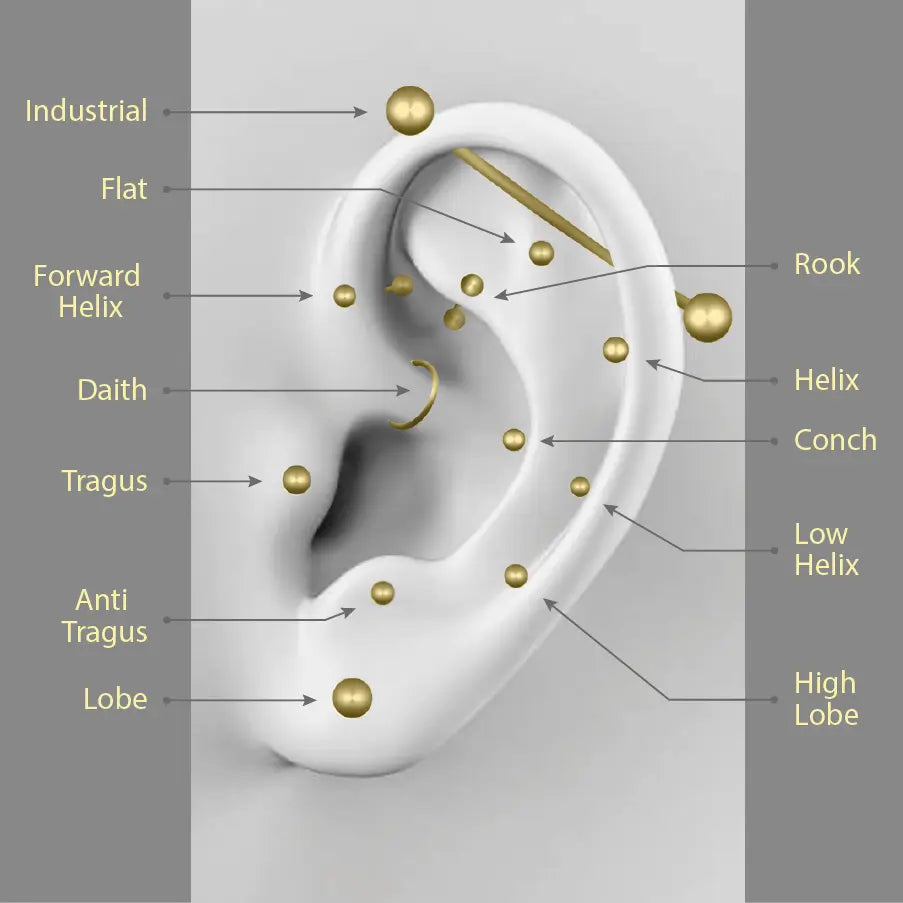
You Ear piercings are one of the most popular forms of personal expression—and contrary to popular belief, they extend far beyond the lobe. Helix, tragus, conch, rook, and daith are just some of the options that allow for unique, subtle, or bold designs.
If you're thinking about getting your ears pierced, or you already have piercings and want to change your jewelry, this guide is for you. We'll cover the main types of ear piercings, the best jewelry for each area, and the safest material: implant-grade titanium.
Types of Ear Piercings
Each area of the ear has different anatomical characteristics, and this influences the choice of jewelry. These are the most common types:
🔹 Lobe
The classic. Ideal for labrets, thin hoops, or multi-hole designs.
🔹 High Lobe
A version higher up on the lobe — ideal for complementing a piercing composition with small labrets or zirconias.
🔹 Helix
Made in the upper cartilage of the ear. It looks perfect with plain hoops, zirconia hoops, or minimalist labrets.
🔹 Low Helix
It's located in the lower part of the cartilage, near the lobe. It looks beautiful with soft hoops or minimalist bars.
🔹 Forward Helix
On the front of the cartilage, facing the face. A small piercing with a lot of presence. It looks stunning with discreet labrets or pieces with cubic zirconia.
🔹 Tragus
Located in the small protrusion in front of the ear canal. It requires a small, secure, and comfortable piece of jewelry—such as an internally threaded titanium labret.
🔹 Anti-Tragus
It sits just above the earlobe, in front of the tragus. It looks amazing with labrets or small jewelry.
🔹 Flat
On the flat area of the cartilage, above the conch. Ideal for tops with creative designs, stones, or opals.
🔹 Conch
Piercing on the inside of the ear. Very popular with larger diameter hoops or decorated bars.
🔹 Rook
Made in the inner fold of the cartilage. It is usually adorned with curved bars or horseshoe-shaped jewelry.
🔹 Daith
Located on the inner cartilage, near the ear canal. A favorite for those who want a striking yet discreet hoop.
🔹 Industrial
Two piercings connected by a single long barbell, usually at the top of the ear. Requires aligned piercing and a straight titanium barbell—a bold and striking look!
What Jewelry Should You Use for an Ear Piercing?
Choosing the right jewelry depends on the piercing location, your style, and—most importantly—the material. At Piercepective, we work exclusively with implant-grade titanium (ASTM F-136), the safest material recommended by professionals.
The most used models:
- Labrets – ideal for tragus, helix, lobe, conch and flat
- Rings (plain or with stone) – for lobe, helix, conch and daith
- Horseshoes – perfect for rook and daith
- Curved bars – used in rook or daith
- Straight bars – for industrial
Essential Ear Piercing Care
Even with the best jewelry, care is essential to ensure healthy healing:
- Cleanse with sterile saline solution twice a day
- Avoid sleeping on the piercing for the first few months.
- Do not change the jewelry before complete healing.
- Sanitize your hands every time you touch the area.
Remember: poor-quality jewelry can cause irritation, infection, or rejection. Therefore, always choose implant-grade titanium jewelry—like the kind you find at Piercepective.
Where to Buy Safe Ear Piercing Jewelry?
If you're looking for quality, safety, and design, you're in the right place. Pierceptive, you have access to:
- ASTM F-136 Implant Grade Titanium Jewelry
- Various options for each type of piercing
- Internal threads that do not damage the fabric
- Customer support
- Fast shipping
👉 Explore our collection now Ear Piercings.
